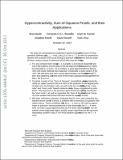Hypercontractivity, sum-of-squares proofs, and their applications
Author(s)
Barak, Boaz; Brandao, Fernando G.S.L.; Harrow, Aram W.; Steurer, David; Zhou, Yuan; Kelner, Jonathan Adam; ... Show more Show less
DownloadKelner_Hypercontractivity.pdf (516.7Kb)
OPEN_ACCESS_POLICY
Open Access Policy
Creative Commons Attribution-Noncommercial-Share Alike
Terms of use
Metadata
Show full item recordAbstract
We study the computational complexity of approximating the 2-to-q norm of linear operators (defined as |A|[subscript 2->q] = max[subscript v≠ 0]|Av|[subscript q]/|v|[subscript 2]) for q > 2, as well as connections between this question and issues arising in quantum information theory and the study of Khot's Unique Games Conjecture (UGC). We show the following: For any constant even integer q ≥ 4, a graph G is a small-set expander if and only if the projector into the span of the top eigenvectors of G's adjacency matrix has bounded 2->q norm. As a corollary, a good approximation to the 2->q norm will refute the Small-Set Expansion Conjecture --- a close variant of the UGC. We also show that such a good approximation can be obtained in exp(n[superscript 2/q]) time, thus obtaining a different proof of the known subexponential algorithm for Small-Set-Expansion. Constant rounds of the "Sum of Squares" semidefinite programing hierarchy certify an upper bound on the 2->4 norm of the projector to low degree polynomials over the Boolean cube, as well certify the unsatisfiability of the "noisy cube" and "short code" based instances of Unique-Games considered by prior works. This improves on the previous upper bound of exp(log[superscript O(1)] n) rounds (for the "short code"), as well as separates the "Sum of Squares"/"Lasserre" hierarchy from weaker hierarchies that were known to require ω(1) rounds. We show reductions between computing the 2->4 norm and computing the injective tensor norm of a tensor, a problem with connections to quantum information theory. Three corollaries are: (i) the 2->4 norm is NP-hard to approximate to precision inverse-polynomial in the dimension, (ii) the 2->4 norm does not have a good approximation (in the sense above) unless 3-SAT can be solved in time exp(√n poly log(n)), and (iii) known algorithms for the quantum separability problem imply a non-trivial additive approximation for the 2->4 norm.
Description
Original manuscript October 30, 2012
Date issued
2012-05Department
Massachusetts Institute of Technology. Department of Mathematics; Massachusetts Institute of Technology. Department of Physics; McGovern Institute for Brain Research at MITJournal
Proceedings of the 44th symposium on Theory of Computing (STOC '12)
Publisher
Association for Computing Machinery (ACM)
Citation
Boaz Barak, Fernando G.S.L. Brandao, Aram W. Harrow, Jonathan Kelner, David Steurer, and Yuan Zhou. 2012. Hypercontractivity, sum-of-squares proofs, and their applications. In Proceedings of the 44th symposium on Theory of Computing (STOC '12). ACM, New York, NY, USA, 307-326.
Version: Original manuscript
ISBN
9781450312455